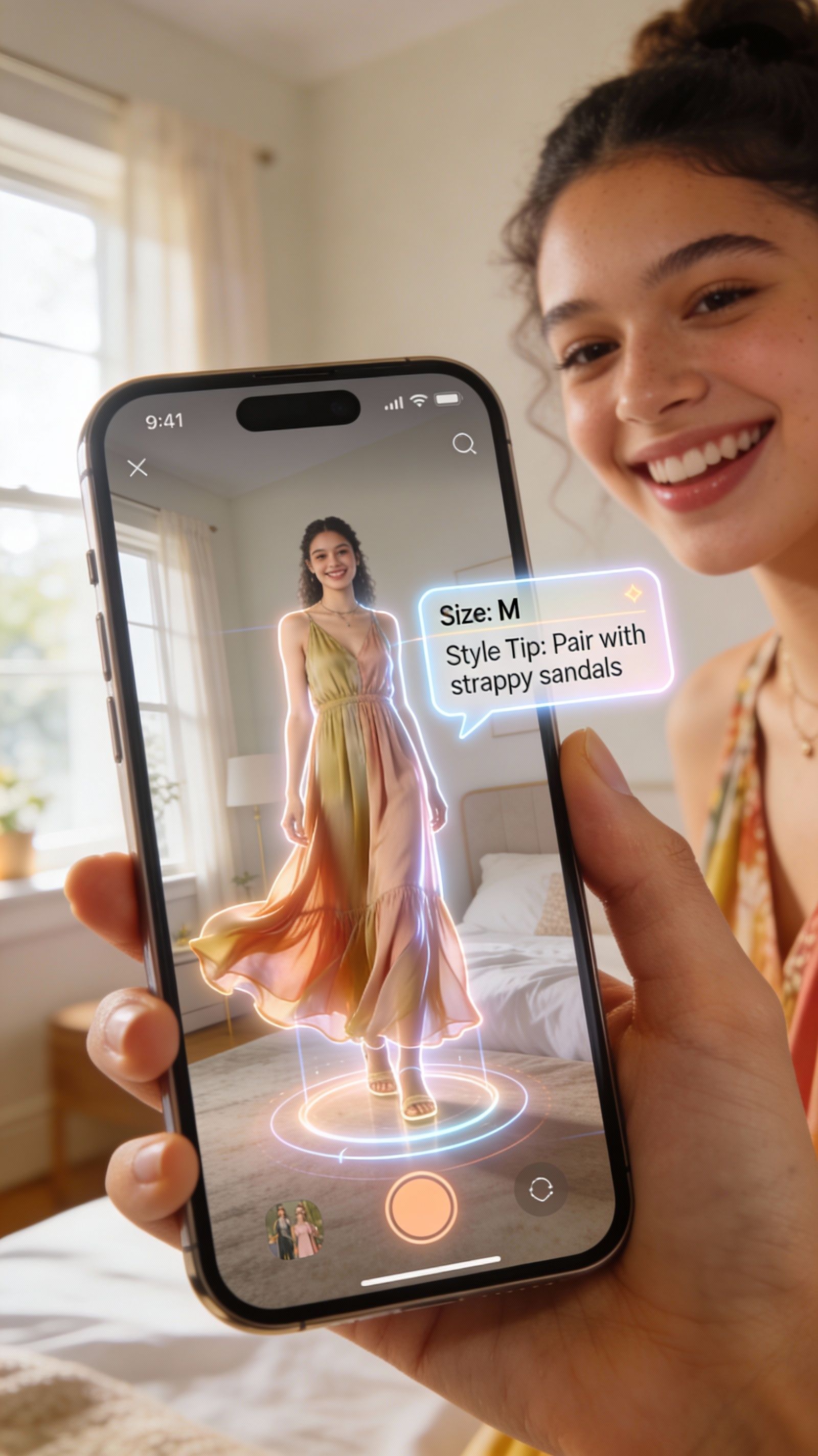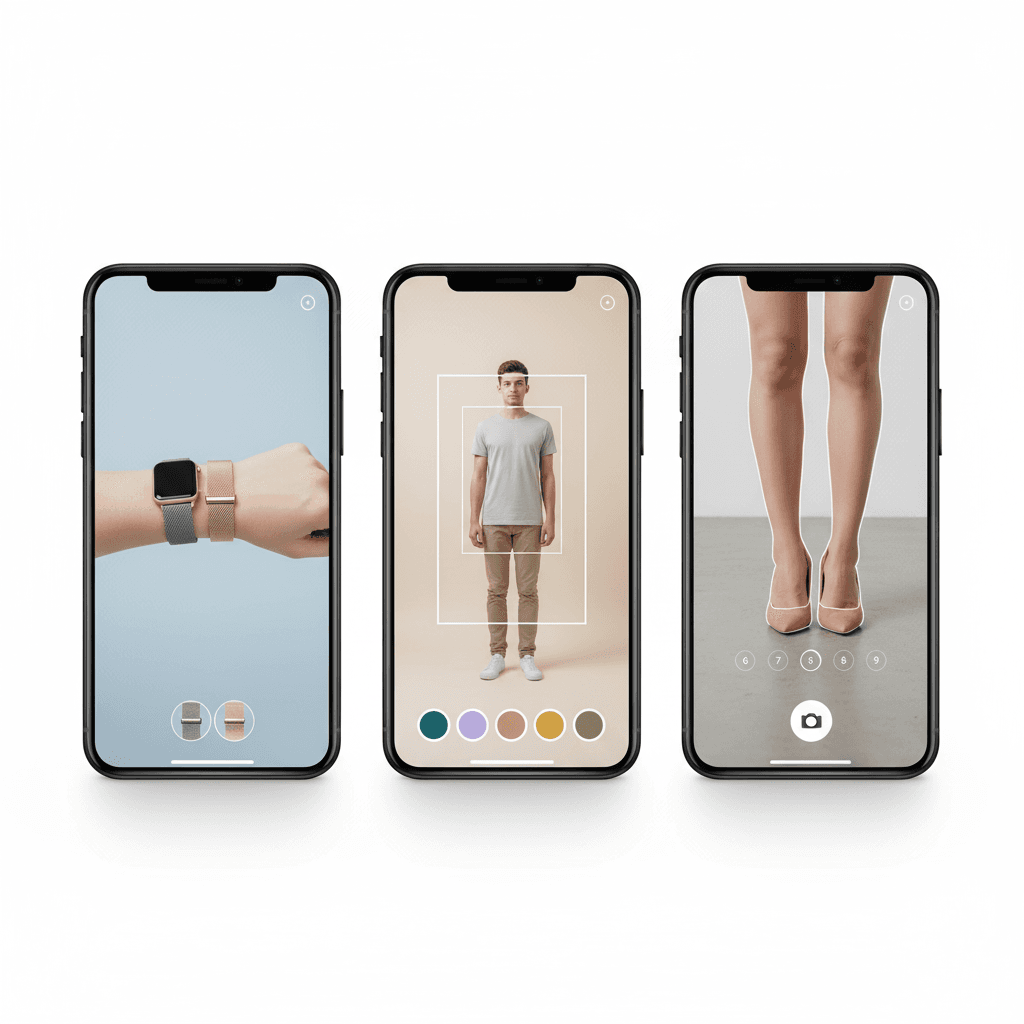How Augmented Reality Retail Shopping Is Changing Fashion?
Fashion Tech 2025: New Upcoming Technology That Will Rule


The fashion industry is on the cusp of a radical transformation, driven by innovations in artificial intelligence (AI), augmented reality (AR), machine learning, smart textiles, and blockchain technology. As the global demand for personalized, immersive, and sustainable fashion intensifies, 2025 is expected to be a milestone year for fashion tech.
Emerging platforms like Glance are already integrating real-time fashion recommendations, AR try-ons, and AI-driven styling directly onto users’ lock screens, giving fashion brands a futuristic interface to reach digital-first consumers. The era of fashion being led solely by trends and designers is evolving into a data-powered, tech-fueled revolution.
What Do We Mean by Fashion Technology Today?

Fashion technology refers to the intersection of innovation and design, where digital tools and smart processes are integrated into every stage of the fashion value chain—from ideation to consumer experience. The goal is to create fashion that is more intelligent, responsive, inclusive, and efficient.
Key components of fashion technology in 2025 include:
- AI-Driven Fashion Design: Algorithms analyze consumer preferences and market trends to generate designs, cuts, and color palettes.
- Augmented Reality Try-Ons: AR enables users to try clothes virtually before purchasing, reducing guesswork and returns.
- Digital Fashion for Avatars: With the rise of virtual influencers, games, and the metaverse, digital clothing is becoming a major category.
- Blockchain for Authenticity: Used to certify the provenance of luxury goods, ensuring transparency and preventing counterfeiting.
- Smart Wearables and E-textiles: Fashion meets function with fabrics that monitor health, track biometrics, or react to environmental changes.
The Evolution of Fashion Tech into a Digital-First Powerhouse
Fashion has evolved from being simply aesthetic to becoming algorithmic. This shift can be seen across three stages:
- Early 2000s to 2015: Digitization of fashion started with the rise of e-commerce, influencer marketing, and online brand presence.
- 2016 to 2022: AI, AR, and mobile-first apps transformed the consumer experience. Brands began using big data for product recommendations and inventory planning.
- 2023 and beyond: The focus is now on personalization at scale, digital ownership (via NFTs), immersive commerce, and sustainable production using technology.
By 2025, this digital-first approach will dominate retail strategies, and physical stores will increasingly incorporate tech-enabled touchpoints.
Top New Upcoming Technology Trends in Fashion for 2025
AI for Fashion Forecasting and Hyper-Personalization
AI is enabling fashion houses to analyze thousands of data points in real-time—from social media sentiment to weather patterns—to forecast trends. Additionally, AI algorithms personalize shopping journeys based on past behavior, location, and preferences.
Augmented Reality-Based Shopping Experiences
AR allows customers to see how an outfit would look on them without entering a store. Major brands like Zara and Nike are already using AR-powered mirrors and mobile apps to enhance customer engagement.
Digital Clothing and Avatar Fashion
As digital identities gain prominence, consumers are investing in clothing for virtual avatars. Platforms like Roblox, Zepeto, and Meta are fueling a new market where fashion is virtual but ownership and exclusivity are real.
Smart Textiles and E-Fabrics
These next-gen textiles go beyond appearance. Some change color with temperature and others monitor heart rate or hydration levels. Such applications are relevant not just for fashion but also for sports, military, and healthcare.
On-Demand Production and 3D Printing
By 2025, expect a rise in 3D-printed garments and localized, on-demand production hubs. This reduces waste, minimizes overstocking, and brings down manufacturing lead times drastically.
Why New Upcoming Technology in Fashion Matters in 2025
The fashion industry has long been criticized for its environmental impact, overproduction, and slow adaptation to digital change. These challenges are now being addressed through technology.
- Sustainability: On-demand fashion and accurate demand forecasting mean fewer unsold clothes and lower carbon footprints.
- Customization: Consumers no longer want one-size-fits-all. Technology enables tailored designs, personalized fits, and targeted experiences.
- Inclusivity and Accessibility: From adaptive clothing to voice-assisted fashion discovery, technology is helping brands cater to a broader audience.
- Agility in Design and Supply Chain: Smart software helps brands pivot rapidly with trend changes and optimize inventory planning.
5 Innovations That Will Shape Fashion in 2025
1. AI-Powered Styling Assistants
AI stylists will analyze your wardrobe, body type, and fashion goals to suggest personalized outfits, creating a seamless blend of tech and taste.
2. Virtual Fitting Rooms and Smart Mirrors
In-store smart mirrors will simulate real-time outfit previews with lighting and angle adjustments, enhancing convenience and hygiene.
3. Fashion NFTs and Digital Ownership
Non-fungible tokens (NFTs) are gaining traction as digital receipts and collectibles. They provide proof of authenticity and ownership in a digital world.
4. Eco-conscious fabrics with Built-In Tech
Materials embedded with tech can now be recycled more efficiently or biodegraded without leaving toxins behind, promoting a circular economy in fashion.
5. Gesture and Voice-Controlled Interfaces
Voice commands and motion sensors will let consumers explore collections and finalize purchases without touching a screen—particularly useful in post-pandemic retail settings.
The Upside of Fashion Technology in 2025
Technology is offering the fashion industry:
- Data-Driven Insights: Faster reactions to trends and consumer behavior.
- Lower Operational Costs: Automated inventory management and AI in logistics reduce waste and manual labor.
- Sustainable Solutions: From 3D printing to blockchain verification, sustainability is built into the supply chain.
- Democratized Fashion: Small designers can now access global markets using digital platforms and smart manufacturing.
Challenges That Come with New Upcoming Technology in Fashion
Despite its promise, fashion technology faces several hurdles:
- Digital Divide: Not all consumers or regions are equipped to adopt digital fashion tools.
- Cost Barriers: High investment in tech infrastructure can limit adoption for emerging designers and small brands.
- Privacy and Data Ethics: AI relies on user data, raising concerns about surveillance and misuse of personal information.
- Tech Dependency: Overreliance on automation could reduce creative spontaneity and limit hands-on craftsmanship.
Brands must strike a balance between technological advancement and human-centered design.
Fashion Meets Glance: Redefining Discovery in the Digital Age
As the discovery layer of next-gen content and commerce, Glance offers a powerful platform for fashion brands to deliver curated, AI-powered experiences. By analyzing user behavior in real-time, Glance helps brands connect with their audience more meaningfully—directly on the lock screen.
Whether it’s showcasing AR previews, launching digital collections, or personalizing looks for each user, Glance enables fashion discovery that feels intuitive and inspiring. It embodies the future of fashion engagement—where tech doesn’t just support style, it defines it.
Future of Fashion Technology: A Glimpse into 2030 and Beyond
As we move beyond 2025, the role of technology in fashion will continue to evolve at an exponential pace. Here's what we can expect from the future of fashion technology in the coming decade:
- Fully Integrated AI-Driven Design
By 2030, AI will not just support fashion design but will be central to it. Algorithms will be able to design collections, predict fashion trends, and create entire wardrobes based on individual preferences, all with minimal human intervention. As AI continues to learn and adapt, the creative process will become more personalized and efficient. - Complete Virtual Reality Fashion
Imagine a world where physical clothing no longer defines your wardrobe. By 2030, we will see fully immersive virtual reality fashion experiences, where digital clothing not only exists in virtual worlds but also in augmented retail experiences. Consumers will purchase digital outfits for both their avatars and themselves, allowing them to express their style in both physical and digital realms. - Blockchain-Driven Transparency and Sustainability
Blockchain technology will become a core part of the fashion supply chain, ensuring complete transparency from the sourcing of raw materials to the final product. In the future, consumers will be able to trace the entire journey of their garments, ensuring that they are ethically sourced and sustainably made. Blockchain will also support the growth of the circular economy in fashion by enabling digital ownership and resale of clothing. - Advanced Smart Textiles and Wearables
The next frontier in fashion will be the development of textiles that not only change color or shape but can actively monitor health metrics, adjust temperature, or even generate energy. Wearable tech will become an integral part of everyday fashion, with garments that provide real-time health monitoring, seamless communication, and enhanced functionality. - Sustainable Fashion Powered by Tech Innovations
By 2030, the fashion industry will experience a complete overhaul, driven by sustainable tech innovations such as 3D printing, biodegradable fabrics, and energy-efficient manufacturing processes. Fashion will become completely circular, with clothes being designed for long-lasting use, reuse, and recycling, powered by AI and robotics.
Conclusion: The Future of Fashion is Smarter, More Personalized, and Sustainable
The future of fashion is being reshaped by intelligent technology. As 2025 approaches, expect a fashion industry where innovation is no longer optional—it is foundational. Brands that embrace AI, AR, digital clothing, and sustainable smart textiles will not only lead the trend but also redefine how we understand clothing and self-expression.
Fashion is no longer just what we wear—it is how we experience, interact with, and shape the world around us. Technology is making this journey more personalized, immersive, and sustainable than ever before.
FAQs: New Upcoming Technology in Fashion
Q1. Which technology will dominate fashion in 2025?
AI for personalization, AR for virtual try-ons, and blockchain for transparency are expected to lead the fashion tech movement.
Q2. How is AI changing the fashion industry?
AI is reshaping the fashion industry by improving how brands design, produce, and sell clothing. It powers trend forecasting with real-time data, helps designers test ideas digitally, and makes supply chains more efficient by predicting demand more accurately. On the customer side, AI enables virtual try-ons, personalized recommendations, and AI-generated models that reduce the need for traditional photoshoots. These advances make fashion faster and more user-centric, but they also introduce challenges around intellectual property and the impact on creative and operational jobs. The industry is learning to balance innovation with responsibility as AI becomes more deeply integrated into everyday fashion experiences.
Q3. What is the top fashion tech megatrend in 2025?
The biggest trend is the fusion of fashion and digital identity—think digital avatars, virtual clothing, and immersive experiences.
Q4. Will virtual fashion replace real clothing by 2050?
While virtual fashion will dominate digital environments, it is likely to complement rather than replace physical clothing.
Q5. What will fashion look like by 2030?
Fashion in 2030 will be driven by sustainability, smarter tech, and more fluid style. Clothes will be made from eco-friendly and recycled materials, and circular models like resale and rental will be mainstream. Digital fashion will grow, with virtual outfits used across social platforms and metaverse spaces. AI will reshape design, sizing, and personalization. Overall, style will be more adaptable, inclusive, and planet conscious, blending physical and digital wardrobes seamlessly.






